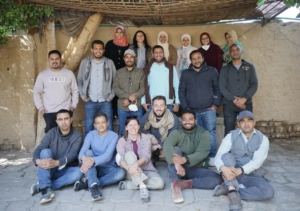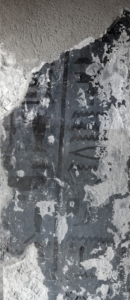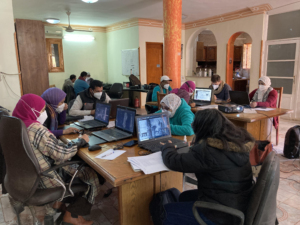- Era18th Dynasty
- Project DirectorDr. JJ Shirley
- LocationLuxor
- AffiliationUniversity of Pennsylvania
- Project SponsorAntiquities Endowment Fund
- Project dates: 2021-2022

2022 TT110 Publication Field School team and students.
Back row, from left to right: Ms. Halaa Ahmed, Mrs. Amira Fahim, Ms. Nadia Abd el-Latef, Mrs. Shaimaa Mandour, Ms. Rasha Ahmed, Ms. Rehab Sabry
Middle row, from left to right: Mr. Alaa Talaat, Mr. Hussein Hofny, Mr. Ahmed ElNasseh, Mr. Walid Abd el-Raheem, Mr. Mahmoud Hassan, Mr. Sayed Rekaby
Front row, from left to right: Mr. Sayed Mamdouh, Dr. Hassan Aglan, Dr. JJ Shirley, Mr. Marco Repole, Mr. Hazem Shared, Mr. Yaser Mahmoud.
Written by: Dr. JJ Shirley
The 18th Dynasty tomb of Djehuty lies on the Theban west bank, in the area of the necropolis referred to as Sheikh Abd el-Qurna. This official served as a royal butler under Hatshepsut, and then continued under her successor Thutmose III, when he was promoted to the position of royal herald. The tomb is unique among those of the same period because images of both Hatshepsut and Thutmose III are main features of its decorative program. In 2014 the TT110 Epigraphy and Research Field School was formed to completely document the entire tomb and serve as a training ground in recording methodologies for Egyptian archaeologists. You can read about the earlier work by the field school on ARCE’s website, and take a virtual tour through ARCE’s partnership with Google Arts & Culture.
After a hiatus due to the coronavirus pandemic, in 2021-2022 the Theban Tomb 110 Field Project returned to Luxor to prepare for and conduct a Publication Field School designed to give the Ministry of Antiquities students from previous field school years their final course in advanced digital epigraphy and publication.
While TT110 has been conserved, there is still significant blackening of much of the tomb’s painted walls, making these areas difficult to draw. The goal of the short 2021 season was for the Project Photographer, Mr. Marco Repole, to fully document TT110 using infrared photography. This method of photography would allow us to “see” through the blackened areas and enable our students to digitally reproduce the painted walls, as well as allow us to check for any new information that might appear on the carved walls.

Mr. Marco Repole in TT110 photographing scenes in the passage (left) using infrared photography.

Example of infrared photography result from the left (north) door jamb leading from the passage into the rear room of TT110.
During the 2022 season approximately half of our full complement of 22 trained students returned for the final Field School courses. Dr. Hassan Aglan returned as our Project Digital Epigrapher and instructed the students in producing digital epigraphic facsimiles from infrared photographs, including discussions of how to use the layer function in Illustrator to document the different circumstances found on the walls – natural damage, intentional damage, painted lines, trace lines, etc. An important part of the drawing process is to consistently check your work against the actual image or wall, and so I, along with Mr. Yaser Mahmoud and Mr. Sayed Mamdouh made several trips to TT110 with the students in order to do just this. Certainly a benefit of working in real-time in Luxor! In addition, I worked with the students in researching parallels to their scenes from contemporary tombs in order to aid the epigraphy process. This included examining images from published tombs as well as visiting open tombs of the same period located in the Theban necropolis.
The publication training that we gave to the students was varied and intended to encompass a variety of aspects that they might encounter in their own work. Mr. Repole provided training in using Photoshop to enhance photographs for drawing and publication purposes. He was assisted in these efforts by Mr. Mahmoud and Mr. Mamdouh, both of whom have prepared digital drawings from photographs in their own work. Mr. Aglan instructed the students in how to join their drawings within Illustrator to create whole wall scenes and in the different ways to prepare drawings for publication.

Field School students Mr. Sayed Rekaby and Ms. Rasha Ahmed in TT110 discussing and comparing their drawings to the wall areas they were assigned to digitally record.
As Project Director and Researcher, I gave the students courses in academic writing, preparing work for publication, and lecture presentation; I was ably assisted in these efforts via Zoom by the Project Epigrapher Mr. Will Schenk.
By the end of the 2022 TT110 Publication Field School, all of the students have become qualified digital epigraphers, able to carry out their own digital drawing programs, and with the skills to see their own work through from beginning research to publication. In addition, the work of the students in undertaking the digital documentation of TT110 has resulted in a full documentation of all the tomb’s painted walls. I am immensely proud of all that the TT110 Field School students have accomplished, and look forward to publishing the results of our work in the coming years.

Field School students working on their digital epigraphy drawings in the ARCE offices.